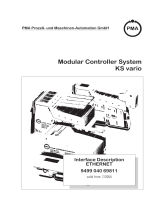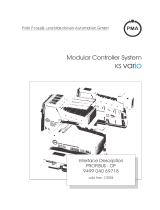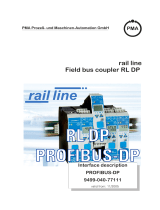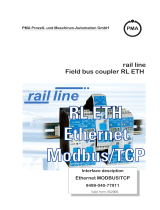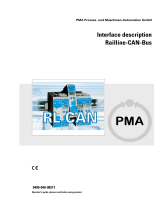Page is loading ...

Modular Controller System
KS vario
Interface Description
Modbus-Protocol
9499 040 69611
valid from: 7/2004
PMA Prozeß- und Maschinen-Automation GmbH

© PMA Prozeß- und Maschinen-Automation GmbH ·Printed in Germany
All rights reserved.
No part of this document may be reproduced or published in any form or by any means
without prior written permission from the copyright owner.
A publication of PMA Prozeß- und Maschinen Automation
P.O.Box 310229
D-34058 Kassel
Germany

3 KS VARIO Modbus
Content
1 General ...........................................5
2 Interface connection, indicator LED signification ...................6
2.1 RS 485/422 interface version..............................6
2.2 Signification of indicator LEDs .............................6
3 General information on the RTU Modbus protocol ...................7
3.1 General message structure ...............................7
3.2 Baudrates (bAud) ....................................7
3.3 Parity (PrtY) .......................................7
3.4 CRC...........................................8
3.5 End identier .......................................8
3.6 Delayed reply (dELY) ..................................8
4 Modbus function format ..................................9
4.1 Modbus addresses ...................................9
4.2 Function codes.....................................13
4.2.1 Read process data data, parameter or configuration data .........13
4.2.2 Write a single datum (process data, parameter or configuration)......14
4.3 Diagnosis .......................................15
4.3.1 Returning a received message ........................16
4.3.2 Communication restart (terminates the listen-only mode) .........16
4.3.3 Returning the diagnosis register .......................16
4.3.4 Changing to listen-only mode ........................16
4.3.5 Deleting the counters and diagnosis register ................16
4.3.6 Returning the message counter .......................16
4.3.7 Returning the counter of faulty message transmissions ..........16
4.3.8 Returning the counter of the messages replied with error message ....17
4.3.9 Returning the counter of messages for this slave ..............17
4.3.10 Returning the counter of non-replied messages...............17
4.3.11 Returning the counter of messages replied with NAK ...........17
4.3.12 Returning the counter of messages replied with busy ...........17
4.3.13 Returning the counter with parity error ...................17
4.3.14 Returning the counter with framing error ..................17
4.3.15 eturning the counter of too long messages .................18
4.4 Writing several process data data, parameter and configuration data .......18
4.5 read-out and specification of data in float format ..................19
5 Error report .........................................20
6 Hints on operation.....................................21
6.1 Connecting the interface ...............................21
6.1.1 Cable installation...............................21
6.2 System construction..................................21
6.2.1 Minimum equipment of a MODBUS system ................21
6.2.2 Maximum equipment of a Modbus system .................21
6.2.3 Cable run inside buildings ..........................22

KS VARIO Modbus 4

.1General
Various fieldbus interfaces can be connected to Modular Controller System KS VARIO. For this, the relevant bus coupler
is used as a central station for the controller system.
One of these bus couplers serves to support the Modbus protocol via a front-panel RS485/422 interface, which permits
transmission of all process, parameter and configuration data.
The serial communication interface can be used for communication with supervisory systems, visualization tools, etc.
Another interface, which is always provided as standard, is on the KS VARIO controller modules. This full RS232
interface is used for connection of the ‘BlueControl’ tool, which runs on a PC.
This interface also uses the Modbus protocol. Communication is according to the master/slave principle.
KS VARIO is always slave.
Characteristic data of the cable medium and the physical and electrical interface properties are :
•Network topology
Linear bus with bus terminating resistors at both ends.
•Transfer medium
Screened, twisted 2 / 5-wire copper cable
•Baudrates and cable lengths (without repeater)
The maximum cable length of 1000m must not be exceeded.
The following Baudrates are supported:
38400 Baud
19200 Baud
9600 Baud
4800 Baud
2400 Baud
•Interface
RS485 /RS422 with AMP flat-pin connectors; can be mounted at the site
•Addressing: 0 ... 247
Address setting via engineering tool
•32 instruments in a segment. Can be extended to 247 by means of repeaters.
General
5 KS VARIO Modbus

.2Interface connection, indicator LED signification
2.1 RS 485/422 interface version
Both the RS422 and the RS485 interface of the electrical interface can be used. The KS VARIO system Modbus coupler
detects the connected version automatically.
The connection has to be done via a 9-pole Sub-D-female connector:
1. N.C.
2. GND
3. TxD-B (DATA-B)
4. RxD-B
5. Via 100 Wto GND
6. N.C.
7. GND
8. TxD-A (DATA-A)
9. RxD-A
qCommunication via RS422
qCommunication via RS485
2.2 Signification of indicator LEDs
LED no. LED colour Function
US green Segment voltage USprovided
UM green Module voltage UMprovided
UB green Coupler voltage UBK provided
D1 red Control by signal TxD of KS
vario (0 = LED on)
D2 red Control by signal RxD of KS
vario (0 = LED on)
Interface connection, indicator LED signification
KS VARIO Modbus 6
5
9
4
8
3
7
2
6
1
RGND
RXD-A
TXD-B
TXD-A
RXD-B
5
9
4
8
3
7
2
6
1
DATA-B
RGND
DATA-A
US
UM
UB
D1
D2
PMA

.3General information on the RTU Modbus protocol
The MODBUS protocol was defined for communication between a supervisory system and the Modicon control system.
ASCII and RTU protocols were defined. Instrument KS VARIO supports the RTU protocol.
The structure for transfer of a byte in the RTU protocol is:
Start bit 8 data bits Parity/stop bit Stop bit
Even or odd parity bit can be selected. Unless a parity bit is selected, an additional stop bit is transferred.
3.1 General message structure
The message is read in into a data buffer with a max. length of 250 bytes. Longer messages are not accepted. The
instrument does not reply.
The message is composed of the following elements:
Instrument address Function code Data CRC End identifier
•Instrument address (Addr)
The instrument address specifies the instrument. Instrument addresses within 1 - 247 can be defined.
Instrument address 0 is used as a broadcast message. A broadcast message can be defined for write orders,
which are handled by all instruments on the bus. As all instruments handle the order, no reply by the instruments
is given.
•Function code
The function code defines the type of a message. There are 17 defined messages. Which messages are
supported is described in chapter ”Data and function control”.
•Data
The data block comprises the further specification of the action defined with the function code. The data block
length is dependent of function code. For further information, see chapter ”MODBUS function format” (chapter 4
). The internal data buffer includes 256 bytes. I.e., max. 120 integer or 60 real data of a message can be written
or read out.
•CRC
The CRC code ensures that transmission errors can be detected. For further information, see chapter ”CRC”.
•End identifier
The end of a message is defined by a time of 3,5 characters without data transfer. For further information, see
chapter ”End identifier”.
3.2 Baudrates (bAud)
The following Baudrates are supported:
38400 Baud
19200 Baud
9600 Baud
4800 Baud
2400 Baud
3.3 Parity (PrtY)
Even, odd or no parity can be selected.
The parity bit can be used for checking, if there was a single error within a byte during transmission.
With even parity, the parity bit is set so that the sum of set bits in the 8-data bits and the parity bit is an even number.
This is applicable analogously to odd parity.
When detecting a parity error during reception, no reply message is generated.
Unless a parity is selected, 1 or 2 stop bits can be output (determination via configuration).
General information on the RTU Modbus protocol
7 KS VARIO Modbus

3.4 CRC
The CRC is a 16-bit value which is appended to the message. This value is used to determine, if the transmission of a
message was detected correctly. In conjunction with parity checking, all possible transmission errors should be
detected.
When detecting a parity error during transmission, no reply message is generated.
The algorithm for generating the CRC is:
•Load the CRC register with FFFF
•Exclusive OR function of the send/receive bytes with the high portion of the CRC register
•Shift the CRC register right by 1 bit
•If the shifted bit was 1, connect the CRC register with value A001 by an exclusive OR function.
•Repeat steps 3 and 4 for the other 7 data bits.
•Repeat steps 2 to 5 for all other send/receive bytes.
•Append the result of the CRC register to the message, starting with the high portion. When checking a receive
message, the result in the CRC register is 0, if the message is handled inclusive of the CRC.
3.5 End identier
The end identifier of a message is specified as rest situation on the Modbus with a length of 3,5 characters. This time
must elapse, before a slave may start its reply, or before a master can send another message.
The evaluation of a message may start, when the rest condition on the Modbus was met during more than 1,5
characters. However, a reply is started only after 3,5 characters.
3.6 Delayed reply (dELY)
Some instruments have a delay when switching over between send and receive mode. This delay can be adjusted in
ms. The adjusted delay is in addition to the 3,5-character waiting time after the end of a message, before generating a
reply.
General information on the RTU Modbus protocol
KS VARIO Modbus 8

.4Modbus function format
The signification of the data range is different dependent of function code. The Modbus protocol defines 17 different
functions.
To permit reading and writing of process data, parameters and configuration data with a minimum number of accesses,
the relevant ranges are grouped together, whereby process data can be defined several times in different groups.
Example for a transmission
Inquiry: Reply:
Field name Value (hex) Signification Field name Value Signification
Address 11 Address 17 Address 11 Address 17
Function 04 Read
parameter/configuration
Function 04 Read
parameter/configuration
Start address high
Start address low
03
EC
Start address 1004 Number of
bytes
06 6 data bytes are sent
Number of values 00
03
Number of values 03 Value1 04
2A
Value1 = 1066
CRC CRC byte1
CRC byte2
Value2 00
8C
Value2 = 140
Value3 10
3E
Value3 = 4158
CRC CRC byte1
CRC byte2
4.1 Modbus addresses
The detailled address-table you find in the document: Parameter List for KS VARIO (9499-040-72911)
The address is coded in 2 bytes. The 2 most significant bits (D15, D14) are used to define the format in which the data
are written or read.
The Modbus directory is divided into equal ranges of 512 words (bit D13...D09). Access to all data for one control
channel (1...30 channels) is possible via each of these ranges.
There are 2 special ranges. All instrument data are stored in the lower part of the address range (Modbus addr. 0..512).
The most important process data of all 30 channels are stored additionally in the following range (addr. 512...1023).
This range is intended for accesses by visualization tools.
The signification of the individual address bits is:
Modbus function format
9 KS VARIO Modbus

INTEGER/ FIX-Point Modbus addresses:
MSB LSB
D15 - D14 D13 - D09 D08 - D00
Data fomat Instr., visualization, channel X
Relevant datum
00: Integer
01: Fix Point 1
1X: Reserved for float
00000: instrument data
00001: visualization data
00010: data channel 1
00011: data channel 2
....
11111: data channel 30
Modbus directory (data format: integer):
Addresses 4000 hex must be added for the Fix Point 1 range.
Addresses Data
0
511 (1FF hex)
Instrument data
512 (200 hex)
1023 (3FF hex)
Visualization range
channel..30
1024 (400 hex)
1535 (5FF hex)
Data channel 1
1536 (600 hex)
2047 (7FF hex)
Data channel 2
.... ....
15872 (3E00 hex)
16383 (3FFF hex)
Data channel 30
Modbus function format
KS VARIO Modbus 10

FLOAT Modbus addresses:
MSB LSB
D15 D14 - D10 D09 - D00
Data format Instr., visualization, channel X
relevant datum
(offset 2)
0: Reserved for Integer
and Fix Point 1
1: Float
00000: instrument data
00001: visualization data
00010: data channel 1
00011: data channel 2
....
11111: data channel 30
Modbus directory (data format: FLOAT):
Addresses Data
32768 (8000 hex)
33791 (83FF hex)
Instrument data
33792 (8400 hex)
34815 (87FF hex)
Visualization area
channel 1..30
34816 (8800 hex)
35839 (8BFF hex)
Data channel 1
35840 (8C00 hex)
36863 (8FFF hex)
Data channel 2
.... ....
64512 (FC00 hex)
65535 (FFFF hex)
Data channel 30
4 bytes are required for storage of these data.
Modbus function format
11 KS VARIO Modbus

Transferable values:
Integer: -30000 ... +32000 (resolution: +/-1)
Fix Point 1: -3000.0 ...+3200.0 (resolution: +/- 0,1)
Float: -1.0 E+037...+1.0 E+037 (resolution: +/- 1.4E-045)
The following special values are defined for transmission in integer format:
-31000 This datum is not defined. This value is returned by the controller
unless a datum within the block is defined when reading a block.
-32000 The function is switched off.
-32768 Corresponds to 0x8000 hex. The value to be transmitted is out of
the transferable integer range.
The following special values are defined for transmission in float format:
-1.5E37 This datum is not defined. This value is returned by the controller
unless a datum within a block is defined when reading a block.
In the code tables (chapter 8), the addresses of each parameter for the relevant data format are specified in decimal
values (Addr. = integer without digits behind the decimal point; 1 dP = integer with 1 digit behind the decimal point;
real = float (IEEE format)).
Modbus function format
KS VARIO Modbus 12

4.2 Function codes
The following function codes are realized in KS VARIO:
Function code Signification
0x03 Read process data, parameter or configuration data
0x04 Read process data, parameter or configuration data
0x06 Write a single datum (process data, parameter or configuration)
0x08 Diagnosis
0x10 Write several data (process data, parameter or configuration)
4.2.1 Read process data data, parameter or configuration data
The structure of a message is:
Inquiry:
Field name Value Signification
Address 11 Address 17
Function 03 or 04 Read process data data, parameter or configuration data
Start address high
Start address low
04
98
Start address 0498 ( ti1 / channel 1)
Number of values 00
02
2 data
CRC CRC byte1
CRC byte2
Reply:
Field name Value Signification
Address 11 Address 17
Function 03 or 04 Read process data data, parameter or configuration data
Number of bytes 04 4 data bytes are sent
Parameter1 00
B4
Process data data, parameter/configuration datum
0498= 180
Parameter ti2 01
4D
Process data data, parameter/configuration datum
0499= 333
CRC CRC byte1
CRC byte2
Broadcast is not possible.
Unless the 1st parameter / configuration datum was defined, error message ”ILLEGAL DATA ADDRESS” is generated.
Unless other values after the 1st value in the area to be read out are defined, these are entered with value ”NOT
DEFINED VALUE”. This can be used for reading out areas with gaps using a message
Modbus function format
13 KS VARIO Modbus

4.2.2 Write a single datum (process data, parameter or configuration)
The structure of a message is:
Inquiry:
Field name Value Signification
Address 11 Address 17
Function 06 Write a single datum (process data, parameter or configuration)
Write address high
Write address low
0D
57
Write address 15990 (SetpInterface of channel 30)
Value = 123 00
7B
CRC CRC byte1
CRC byte2
Reply:
Field name Value Signification
Address 11 Address 17
Function 06 Write a single datum (process data, parameter or configuration)
Write addr. high
Write addr. low
3E
76
Write address 15990 (SetpInterface of channel 30)
Value = 123 00
7B
CRC CRC byte1
CRC byte2
The structure of a correct reply message is exactly as defined.
Broadcast is possible.
Entry in real data format is not possible, because only values of 2 bytes can be transmitted.
If the value is out of the adjustable range, error message ”ILLEGAL DATA VALUE” is generated. The datum remains
unchanged.
Unless the datum can be written (e.g. configuration datum and the instrument is on-line), error message ”ILLEGAL
DATA VALUE” is generated.
Modbus function format
KS VARIO Modbus 14

4.3 Diagnosis
Using a diagnosis message, the controller can be caused to return check messages, to go to operating statuses, to
output counter states or to reset the counters.
Broadcast is generally not possible.
The following functions were defined:
Code Signification
0x00 Return the received message
0x01 Communication restart (terminates the listen-only mode)
0x02 Status register feedback
0x04 Change to the listen-only mode
0x0A Delete counters and reset the diagnosis register
0x0B Return the message counter (all messages on the bus)
0x0C Return the counter of faulty message transmissions to this slave (parity or CRC error)
0x0D Return the counter of messages replied with error message
0x0E Return the counter of messages for this slave
0x0F Return the counter of non-replied messages
0x10 Return the counter of messages replied with NAK
0x11 Return the counter of messages replied with busy
0x12 Return the counter of too long messages
0x40 Return the parity error counter
0x41 Return the framing error counter (stop bit not detected)
0x42 Return the buffer full counter (message longer than receive buffer)
Inquiry in integer format
When using the setting for integer with digits behind the decimal point with the address (3 most significant address
bits), the counter statuses are incremented according to the relevant conversion factor.
Inquiry in float format
When using the setting for float with the address (3 most significant address bits are 100), the counter statuses are
transmitted in IEEE format. The highest value is 65535, because the counters in the instrument are designed as word
counters.
In float format, a 4-byte data field is returned when reading the counter statuses. In all other cases, reply is with a
2-byte data field.
When switching over to listen mode (0x04) and with restart after switching the instrument to listen mode, no reply is
generated.
When receiving a restart diagnosis message whilst the instrument is not in listen mode, the instrument generates a
reply.
The general structure of a diagnosis message is:
Inquiry:
Field name Value Signification
Address 11 Address 17
Function 08 Diagnosis message
Sub-function high
Sub-function low
00
YY
Sub-function code
Data field Byte 1
Byte 2
Further data definitions
CRC CRC byte1
CRC byte2
Modbus function format
15 KS VARIO Modbus

4.3.1 Returning a received message
Definition of received and returned data
Sub-function Received data field Sent data field
00 00 2 bytes with any content Returning received datum
Serves for checking, if the communication works generally.
4.3.2 Communication restart (terminates the listen-only mode)
Definition of received and returned data
Sub-function Received data field Sent data field
00 01 00 00 00 00
The slave is requested to initialize its interface and to delete the event counters. Moreover, the instrument shall leave
the listen-only mode. If the unit was in listen-only mode, no reply is generated.
4.3.3 Returning the diagnosis register
Definition of received and returned data
Sub-function Received data field Sent data field
00 02 00 00 Contents of diagnosis register
The slave sends its 16-bit diagnosis register to the master. Which data are contained in this register can be defined
freely. Information can be (faulty EEPROM, defective LED, etc.).
4.3.4 Changing to listen-only mode
Definition of received and returned data
Sub-function Received data field Sent data field
00 04 00 00 No reply
The slave is requested to stop executing and replying any messages sent to it. This condition can be removed from the
instrument only by means of diagnosis message sub-function 00 01. The normal instrument operating condition can be
re-established also by power up.
The purpose of this function is to switch off a module with faulty behaviour on the Modbus, i.e. to enable the bus to
continue operating. After receiving this message, the instrument does not generate a reply.
4.3.5 Deleting the counters and diagnosis register
Definition of received and returned data
Sub-function Received data field Sent data field
00 0A 00 00 00 00
The slave is requested to delete its event counters and to reset the diagnosis register.
4.3.6 Returning the message counter
Definition of received and returned data
Sub-function Received data field Sent data field
00 0B 00 00 Message counter
The slave is asked to return the value of its message counter.
The counter contains the sum of all messages recorded on the bus, whereby all messages which were sent by the
master and by other slaves are also counted. Its own replies are not included in this value.
4.3.7 Returning the counter of faulty message transmissions
Definition of received and returned data
Sub-function Received data field Sent data field
00 0C 00 00 Counter of faulty message transmissions
The slave is requested to return the value of its counter for faulty message transmission.
The counter contains the sum of all messages sent to the slave, at which an error was detected. These errors can be
CRC errors or parity errors.
Modbus function format
KS VARIO Modbus 16

4.3.8 Returning the counter of the messages replied with error message
Definition of received and returned data
Sub-function Received data field Sent data field
00 0D 00 00 Counter of messages replied with error message
The slave is requested to return the value of its counter for messages replied with error message.
The counter contains the sum of all messages sent to the slave, which were replied with an error message by the
slave.
4.3.9 Returning the counter of messages for this slave
Definition of received and returned data
Sub-function Received data field Sent data field
00 0E 00 00 Counter of messages for this slave
The slave is requested to return the value of its message counter for this slave.
The counter contains the sum of all messages sent to the slave.
4.3.10 Returning the counter of non-replied messages
Definition of received and returned data
Sub-function Receiveddata field Sent data field
00 0F 00 00 Counter of non-replied messages
The slave is requested to return the value of its counter of non-replied messages.
The counter contains the sum of all messages sent to the slave, which were not replied due to internal events or
detected errors.
4.3.11 Returning the counter of messages replied with NAK
Definition of received and returned data
Sub-function Received data field Sent data field
00 10 00 00 Counter of messages replied with NAK
The slave is requested to return the value of its counter of messages replied with NAK.
The counter contains the sum of all messages sent to the slave, which were replied with NAK.
4.3.12 Returning the counter of messages replied with busy
Definition of received and returned data
Sub-function Received data field Sent data field
00 12 00 00 Counter of messages replied with busy
The slave is requested to return the value of its counter of messages replied with busy.
The counter contains the sum of all messages sent to the slave, which were replied with busy.
4.3.13 Returning the counter with parity error
Definition of received and returned data
Sub-function Received data field Sent data field
00 40 00 00 Counter of the number of parity errors
The slave is requested to return the value of its counter with the number of parity errors.
The counter contains the sum of all messages sent to the slave at which a parity error was detected.
4.3.14 Returning the counter with framing error
Definition of received and returned data
Sub-function Received data field Sent data field
00 41 00 00 Counter of the number of framing errors
The slave is requested to return the value of its counter with the number of framing errors.
The counter contains the sum of all messages sent to the slave at which a framing error was detected. Framing error is
detected, unless the stop bit at the end of a byte is detected.
Modbus function format
17 KS VARIO Modbus

4.3.15 Returning the counter of too long messages
Definition of received and returned data
Sub-function Received data field Sent data field
00 42 00 00 Counter of too long messages
The slave is requested to return the value of its counter of too long messages.
The counter contains the sum of all messages sent to the slave at which there was an overflow of the receive buffer or
at which data could not be fetched in time by the UART.
4.4 Writing several process data data, parameter and configuration data
The structure of a message is:
Definition:
Field name Value Signification
Address 11 Address 17
Function 10 Write several process data data, parameter or configuration
data
Start address high
Start addresse low
0D
57
Write address 3415
Number of values 00
02
2 values
Number of bytes 04 4 data bytes are sent
Parameter/configuration
datum 15
00
DE
Process data datum, parameter or configuration datum
3415 = 222
Parameter/configuration
datum 16
01
4D
Process data datum, parameter or configuration datum
3416 = 333
CRC CRC byte1
CRC byte2
Reply:
Field name Value Signification
Address 11 Address 17
Function 10 Write several process data data, parameter or configuration
data
Start address high
Start address low
0D
57
Write address 3415
Number of values 00
02
2 process data data, parameter/configuration data
CRC CRC byte1
CRC byte2
Broadcast is possible.
Unless the 1st value was defined, an error message ”ILLEGAL DATA ADDRESS” is generated.
Unless the 1st value can be written (configuration and instrument is on-line), an error message ”ILLEGAL DATA VALUE”
is generated.
Unless other values in the defined range after the 1st value are defined or can be written instantaneously, these values
are overread. Data in these positions are not changed. The purpose is to change parts with gaps or which cannot be
written instantaneously by means of a message. No error message is output.
If values are out of the adjustable limits, error message ”ILLEGAL DATA VALUE” is generated. Evaluation of the
following data is omitted. Data which were already stored correctly are active.
The Modbus does not provide information related to the error position in its error report. If this is required, a datum
containing the position of the last error must be defined. In case of error, this datum can be read out by the master.
Modbus function format
KS VARIO Modbus 18

4.5 Read-out and specification of data in float format
Level-1 data, parameter and configuration data in float format can be read out and written. (Function codes 03, 04, 16)
Writing single data in float format with code 06 is not possible, since only 2 bytes for the value of the datum can be
transmitted by means of this function.
If data in float format are required, the address of the required datum must be calculated as follows:
Address of the datum in integer format multiplied with factor 2
Addition of an offset of 8000H.
In ”Number of values”, a value twice as high as with a message for data in integer format is required.
Accordingly, the value in field ”Number of data bytes” is twice as high.
All data are always converted into float values. This is also applicable to status or control words.
The data are transmitted in Motorola format (exponent followed by mantissa first).
The float format structure of a message as described in the previous chapter is:
Definition:
Field name Value Signification
Address 11 Address 17
Function 10 Write several process data data, parameter or configuration data
Start address high
Start address low
9A
AE
Write address 2 * 3415 + 8000H for float format
Number of values 00
04
2 values in float format
Number of bytes 08 8 data bytes are sent
Parameter/configuration
datum 15
43 5E
00 00
Process data datum, parameter or configuration datum
3415 = 222
Parameter/configuration
datum 16
43 A6
80 00
Process data datum, parameter or configuration datum
3416 = 333
CRC CRC byte1
CRC byte2
Reply:
Field name Value Signification
Address 11 Address 17
Function 10 Write several process data data, parameter or configuration data
Start address high
Start address low
9A
AE
Write address 2 * 3415 + 8000H for float format
Number of values 00
04
2 process data data, parameter or configuration data in float format
CRC CRC byte1
CRC byte2
Modbus function format
19 KS VARIO Modbus

.5Error report
The error report is generated, when interpretation or changing a datum are not possible, although the message was
received correctly.
When detecting a transmission error, no reply is given. The master must resend the message.
Detected transmission errors are:
•Parity error
•Framing error (no stop bit received)
•Overrun error (receive buffer overflow, or data could not be fetched in time by the UART)
•CRC error
The data structure of the error report is:
Field name Value Signification
Address 11 Address 17
Function 90 Error report for message Write several parameter/configuration data
Error code 02 ILLEGAL DATA ADDRESS
CRC CRC byte1
CRC byte2
In field Function, the most significant bit is set.
The error code is transmitted in the following byte.
The following error codes are defined:
Code Name Signification
01 ILLEGAL FUNCTION The received function code is not defined in the instrument.
02 ILLEGAL DATA ADDRESS The received address is not defined in the instrument.
When reading (function code 01, 03, 04) or writing (function code 0F, 10) several
data simultaneously, this error is generated only, unless the first datum is
defined.
03 ILLEGAL DATA VALUE The received value is out of the adjusted limits or cannot be written
instantaneously (instrument is not in configuration mode).
When writing several data simultaneously (function code 0F, 10), this error is
generated only, unless the first datum can be written.
The Modbus protocol includes further defined error codes, which, however, are presently not supported:
Code Name Signification
04 SLAVE DEVICE FAILURE A non-reproducible error occurred during message processing.
05 ACKNOWLEDGE The instrument has received an inquiry and handles it. As handling takes a very
long time, this reply is output to prevent an interface timeout. The master can poll
the diagnosis, to find out if handling is finished.
06 SLAVE DEVICE BUSY The instrument is busy handling an order. The master must repeat the message
subsequently.
07 NEGATIVE
ACKNOWLEDGE
The instrument cannot handle the requested order. This error message can be
output for changing a configuration datum, although the instrument is not in
configuration mode.
08 MEMORY PARITY ERROR Parity error found when reading the memory.
Error report
KS VARIO Modbus 20
/

